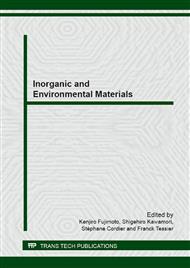p.225
p.229
p.233
p.237
p.243
p.247
p.251
p.256
p.260
Influence of Heat Treatment in Air on Thermoelectric Silicon Clathrate
Abstract:
The influence of heat treatments in air on the surface and thermoelectric properties of polycrystalline silicon clathrate of nominal composition Ba8Al15Si31 was investigated. The samples were prepared by combining arc melting and spark plasma sintering methods. Heat treatments were conducted in air at 873 K for 0-480 h. The surface oxidation was investigated by bulk surface X-ray diffraction (XRD) measurements, scanning electron microscopy (SEM), energy-dispersive X-ray spectroscopy (EDS), and X-ray photoelectron spectroscopy (XPS). The Seebeck coefficient and the electrical conductivity of samples were measured before and after heat treatments. XRD, SEM, EDS, and XPS results revealed that the clathrate phase near the surface was changed to Al-poor clathrate phases and an oxide phase (probably barium aluminate: BaAl2O4). However, the thermoelectric properties of samples were almost unchanged by the heat treatment in air at 873 K for up to 480 h because the chemical composition of the inner part of sample was almost stable.
Info:
Periodical:
Pages:
243-246
Citation:
Online since:
June 2014
Authors:
Price:
Сopyright:
© 2014 Trans Tech Publications Ltd. All Rights Reserved
Share:
Citation:


